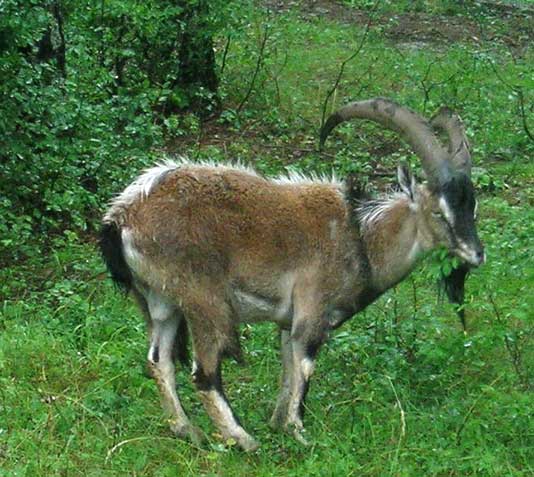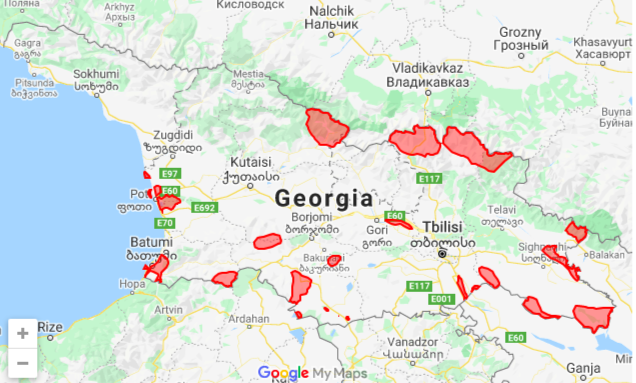Browse by taxonomy
Simple search by name
Name According To: https://www.iucnredlist.org/search?query=Capra%20aegagrus&searchType=species
Species: aegagrus
Taxon Rank: Species
Scientific Name Authorship: Erxleben, 1777
Vernacular Name: Wild Goat (Bezoar goat) (NT)
Georgian Name: ნიამორი
GBD Remarks:
Conservation Status (International): IUCN status (international) Vulnerable A2cd ver 3.1; Pop. trend: decreasing.
Conservation Status (national): Georgian Red List. IUCN National status (2006) CR C2 aII. Prioritized for Action Plan development in the National Biodiversity Strategy and Action Plan for Georgia (2005).
Economic importance (national): interesting as an attraction for eco-tourists and scientists. Under heavy pressure from poaching.
Methodological approaches: Surveys (distance sampling, aerial surveys); camera-trapping; genetic analyses; Habitat suitability modeling.
Contacts and ongoing projects: (1) ISU,Institute of Ecology, Institute of Zoology; (2) NACRES. contact – Zura Gurielidze, Natia Kopaliani, Alexander Gavashlelishvili (ILIAUNI), Bejan Lortkipanidze (NACRES). In 2012-2013 aerial and land surveys, conducted by the Institute of Ecology of ILIAUNI, were funded by the government.
Website: http://nacres.org/lmam12.html
Specific relevant information: Population size in Georgia does not exceed 200 specimens. Ca. 21% are young animals (2012). This is in line with an earlier estimate of ca. 100 individuals (http://nacres.org/lmam12.html). Newer count data from 2013 August are under processing.
Why to monitor: Globally vulnerable and nationally critically endangered. Key species in contributing to the formation of specific mountain ecosystems and an important item of national folklore
Preliminary suggestion: Organize existing data into a user-friendly format freely available on the Internet. Organize annual monitoring at several pre-defined sites in Khevsureti and Tusheti, eastern Georgia, using camera-traps and collecting scats for genetic studies. Monitoring requires two months per year, an expert and 3-4 students.
კონსერვაციული სტატურსი (საერთაშორისო): IUCN სტატუსი, საერთაშორისო მოწყვლადი (VU, A2cd ver 3.1;) პოპულაციის რიცხოვნობა მცირდება.
კონსერვაციული სტატუსი (ეროვნული): საქართველოს წითელი ნუსხა. IUCN ეროვნული სტატუსი (2006) უკიდურესი საფრთხის ქვეშ მყოფი CR C2 aII (ძალზე მცირე ეროვნული არეალი, დაბალი და შემცირებადი რიცხოვნობა). პრიორიტიზირებულია სამოქმედო გეგმის განვითარებისათვის საქართველოს ბიომრავალფეროვნების სტრატეგია და მოქმედებათა გეგმაში (2005).
ეკონომიკური მნიშვნელობა (ეროვნული): საინტერესოა ობიექტია ეკო-ტურისტებისა და მეცნიერებისათვის. განიცდის ბრაკონიერობის მწვავე გავლენას. მნიშვნელოვანი ადგილი უჭირავს ეთნიკურ ფოლკლორში
შესწავლის მეთოდიკა: აღრიცხვა (დისტანციური, აერო-ფოტო გადაღება), ვიდეო ხაფანგები, გენეტიკუსი ანალიზი, ჰაბიტატის მოდელირება. პოპულაციური მოდელირების განხორციელება შესაძლებელია კომპიუტერული პროგრამა DISTANCE (Bukland et al. 2001, Thomas, L., et al. 2010) მეშვეობით. აღნიშნული პროგრამა მუშაობს ვინდოუსის პლათფორმაზე (http://www.ruwpa.st-and.ac.uk/distanc/).
კონტაქტები და მიმდინარე პროექტები: (1)ე კოლოგიის ინსტიტუტი, ზოოლოგიის ინსტიტუტი; (2) ნაკრესი. საკონტაქტო პირი - ზურა გურიელიძე, ნათია კოპალიანი, ალექსანდრე გავაშელიშვილი (ილიაუნი), ბეჟან ლორთქიფანიძე (ნაკერსი). 2012-2013 წლებში აერო-ფოტო და სახმელეთო აღრიცხვა ხორციელდება ეკოლოგიის ინსტიტუტის მიერ, დაფინანსებულია სახელმწიფოს მიერ.
ვებსაიტი: http://nacres.org/lmam12.html
სპეციფიკური ინფორმაცია: ჯამური რიცხოვნობა პირიქითა ხევსურეთში და მთა-თუშეთში არ აღემატება 200 ინდივიდს. ნაშიერების რაოდენობა პოპულაციის დაახლ. 21% შეადგენს (2012 აღრიცხვის შედეგი). ესთანხმობაშია ადრე გაკეთებულ შეფასებასთან (დაახლ. 100 ინდივიდი; http://nacres.org/lmam12.html). 2013 წლის აგვისტოს აღრიცხვის შედეგები დამუშავების სტადიაშია.
წინასწარი რეკომენდაციები: არსებული ინფორმაციის ინტერნეტში განთავსება მომხმარებლისათვის ადვილად აღქმადი ფორმით. ყოველწლიური მობნიტორინგის ორგანიზება რამდენიმე წინასწარ განსაზღვრულ წერტილში, დიდი კავკასიონის ჩრდილოეთ და სამხრეთ ფერდობებზე, საქართველოს არეალის ფარგლებში, ვიდეო-ხაფანგების მეშვეობით და ესკრემენტების შეგროვება გენეტიკური ანალიზისათვის. მონიტორინგისთვის საჭიროა წელიწადში ორი თვე საველე სამუშაო, რომელშიც ერთი ექსპერტი და 3-4 სტუდენტი მიიღებს მონაწილეობას. დამხმარე მეთოდი - პოპულაციის სიმჭირდროვის მოდელირება.
რატომ არის საჭირო მონიტორინგი: გლობალურად მოწყვლადი და ეროვნულ დონეზე უკიდურესი საფრთხის ქვეშ მყოფი. მთის ეკოსისტემების მნიშვნელოვანი სახეობა და მნიშვნელოვანი სიმბოლო ეთნიკურ ფოლკლორში.
Page Authors: Alexander Gavashelishvili ,
Reference of occurrence in Georgia: Bukhnikashvili, A. & Kandaurov, A., 2002. The annotated list of mammals of Georgia. Proceedings of the Institute of Zoology, Tbilisi, XXI: 319-336
Conservation Status
This section is under construction
National Red List Status of have not been evaluated


